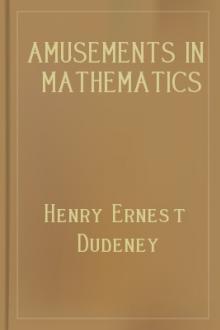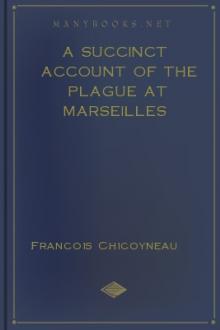Amusements in Mathematics, Henry Ernest Dudeney [books to read to be successful txt] 📗

- Author: Henry Ernest Dudeney
- Performer: 0486204731
Book online «Amusements in Mathematics, Henry Ernest Dudeney [books to read to be successful txt] 📗». Author Henry Ernest Dudeney

151.—THE JOINER'S PROBLEM.—solution

Nothing could be easier than the solution of this puzzle—when you know how to do it. And yet it is apt to perplex the novice a good deal if he wants to do it in the fewest possible pieces—three. All you have to do is to find the point A, midway between B and C, and then cut from A to D and from A to E. The three pieces then form a square in the manner shown. Of course, the proportions of the original figure must be correct; thus the triangle BEF is just a quarter of the square BCDF. Draw lines from B to D and from C to F and this will be clear.
152.—ANOTHER JOINER'S PROBLEM.—solution

The point was to find a general rule for forming a perfect square out of another square combined with a "right-angled isosceles triangle." The triangle to which geometricians give this high-sounding name is, of course, nothing more or less than half a square that has been divided from corner to corner.
The precise relative proportions of the square and triangle are of no consequence whatever. It is only necessary to cut the wood or material into five pieces.
Suppose our original square to be ACLF in the above diagram and our triangle to be the shaded portion CED. Now, we first find half the length of the long side of the triangle (CD) and measure off this length at AB. Then we place the triangle in its present position against the square and make two cuts—one from B to F, and the other from B to E. Strange as it may seem, that is all that is necessary! If we now remove the pieces G, H, and M to their new places, as shown in the diagram, we get the perfect square BEKF.
Take any two square pieces of paper, of different sizes but perfect squares, and cut the smaller one in half from corner to corner. Now proceed in the manner shown, and you will find that the two pieces may be combined to form a larger square by making these two simple cuts, and that no piece will be required to be turned over.
The remark that the triangle might be "a little larger or a good deal smaller in proportion" was intended to bar cases where area of triangle is greater than area of square. In such cases six pieces are necessary, and if triangle and square are of equal area there is an obvious solution in three pieces, by simply cutting the square in half diagonally.
153.—A CUTTING-OUT PUZZLE.—solution

The illustration shows how to cut the four pieces and form with them a square. First find the side of the square (the mean proportional between the length and height of the rectangle), and the method is obvious. If our strip is exactly in the proportions 9x1, or 16x1, or 25x1, we can clearly cut it in 3, 4, or 5 rectangular pieces respectively to form a square. Excluding these special cases, the general law is that for a strip in length more than n² times the breadth, and not more than (n+1)² times the breadth, it may be cut in n+2 pieces to form a square, and there will be n-1 rectangular pieces like piece 4 in the diagram. Thus, for example, with a strip 24x1, the length is more than 16 and less than 25 times the breadth. Therefore it can be done in 6 pieces (n here being 4), 3 of which will be rectangular. In the case where n equals 1, the rectangle disappears and we get a solution in three pieces. Within these limits, of course, the sides need not be rational: the solution is purely geometrical.
154.—MRS. HOBSON'S HEARTHRUG.—solution

As I gave full measurements of the mutilated rug, it was quite an easy matter to find the precise dimensions for the square. The two pieces cut off would, if placed together, make an oblong piece 12x6, giving an area of 72 (inches or yards, as we please), and as the original complete rug measured 36x27, it had an area of 972. If, therefore, we deduct the pieces that have been cut away, we find that our new rug will contain 972 less 72, or 900; and as 900 is the square of 30, we know that the new rug must measure 30x30 to be a perfect square. This is a great help towards the solution, because we may safely conclude that the two horizontal sides measuring 30 each may be left intact.
There is a very easy way of solving the puzzle in four pieces, and also a way in three pieces that can scarcely be called difficult, but the correct answer is in only two pieces.
It will be seen that if, after the cuts are made, we insert the teeth of the piece B one tooth lower down, the two portions will fit together and form a square.
155.—THE PENTAGON AND SQUARE.—solution
A regular pentagon may be cut into as few as six pieces that will fit together without any turning over and form a square, as I shall show below. Hitherto the best answer has been in seven pieces—the solution produced some years ago by a foreign mathematician, Paul Busschop. We first form a parallelogram, and from that the square. The process will be seen in the diagram on the next page.
The pentagon is ABCDE. By the cut AC and the cut FM (F being the middle point between A and C, and M being the same distance from A as F) we get two pieces that may be placed in position at GHEA and form the parallelogram GHDC. We then find the mean proportional between the length HD and the height of the parallelogram. This distance we mark off from C at K, then draw CK, and from G drop the line GL, perpendicular to KC. The rest is easy and rather obvious. It will be seen that the six pieces will form either the pentagon or the square.
I have received what purported to be a solution in five pieces, but the method was based on the rather subtle fallacy that half the diagonal plus half the side of a pentagon equals the side of a square of the same area. I say subtle, because it is an extremely close approximation that will deceive the eye, and is quite difficult to prove inexact. I am not aware that attention has before been drawn to this curious approximation.

Another correspondent made the side of his square 1¼ of the side of the pentagon. As a matter of fact, the ratio is irrational. I calculate that if the side of the pentagon is 1—inch, foot, or anything else—the side of the square of equal area is 1.3117 nearly, or say roughly 13/10. So we can only hope to solve the puzzle by geometrical methods.
156.—THE DISSECTED TRIANGLE.—solution
Diagram A is our original triangle. We will say it measures 5 inches (or 5 feet) on each side. If we take off a slice at the bottom of any equilateral triangle by a cut parallel with the base, the portion that remains will always be an equilateral triangle; so we first cut off piece 1 and get a triangle 3 inches on every side. The manner of finding directions of the other cuts in A is obvious from the diagram.
Now, if we want two triangles, 1 will be one of them, and 2, 3, 4, and 5 will fit together, as in B, to form the other. If we want three equilateral triangles, 1 will be one, 4 and 5 will form the second, as in C, and 2 and 3 will form the third, as in D. In B and C the piece 5 is turned over; but there can be no objection to this, as it is not forbidden, and is in no way opposed to the nature of the puzzle.

157.—THE TABLE-TOP AND STOOLS.—solution

One object that I had in view when presenting this little puzzle was to point out the uncertainty of the meaning conveyed by the word "oval." Though originally derived from the Latin word ovum, an egg, yet what we understand as the egg-shape (with one end smaller than the other) is only one of many forms of the oval; while some eggs are spherical in shape, and a sphere or circle is most certainly not an oval. If we speak of an ellipse—a conical ellipse—we are on safer ground, but here we must be careful of error. I recollect a Liverpool town councillor, many years ago, whose ignorance of the poultry-yard led him to substitute the word "hen" for "fowl," remarking, "We must remember, gentlemen, that although every cock is a hen, every hen is not a cock!" Similarly, we must always note that although every ellipse is an oval, every oval is not an ellipse. It is correct to say that an oval is an oblong curvilinear figure, having two unequal diameters, and bounded by a curve line returning into itself; and this includes the ellipse, but all other figures which in any way approach towards the form of an oval without necessarily having the properties above described are included in the term "oval." Thus the following solution that I give to our puzzle involves the pointed "oval," known among architects as the "vesica piscis."

The dotted lines in the table are given for greater clearness, the cuts being made along the other lines. It will be seen that the eight pieces form two stools of exactly the same size and shape with similar hand-holes. These holes are a trifle longer than those in the schoolmaster's stools, but they are much narrower and of considerably smaller area. Of course 5 and 6 can be cut out in one piece—also 7 and 8—making only six pieces in all. But I wished to keep the same number as in the original story.
When I first gave the above puzzle in a London newspaper, in competition, no correct solution was received, but an ingenious and neatly executed attempt by a man lying in a London infirmary was accompanied by the following note: "Having no compasses here, I was compelled to improvise a pair with the aid of a small penknife, a bit of firewood from a bundle, a piece of tin from a toy engine, a tin tack, and two portions of a hairpin, for points. They are a fairly serviceable pair of compasses, and I shall keep them as a memento of your puzzle."
158.—THE GREAT MONAD.—solution
The areas of circles are to each other as the squares of their diameters. If you have a circle 2 in. in diameter and another 4 in. in diameter, then one circle will be four times as great in area as the other, because the square of 4 is four times as great as the square of 2. Now, if we refer to Diagram 1, we see how two equal squares may be cut into four pieces that will form





Comments (0)